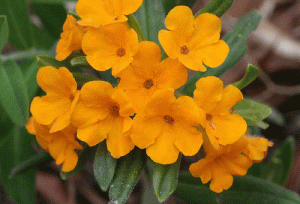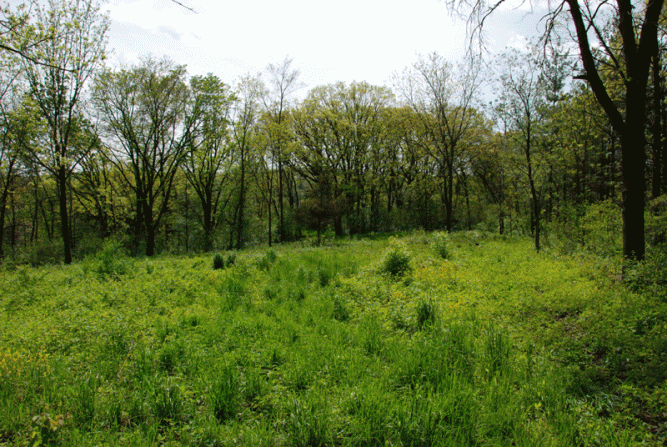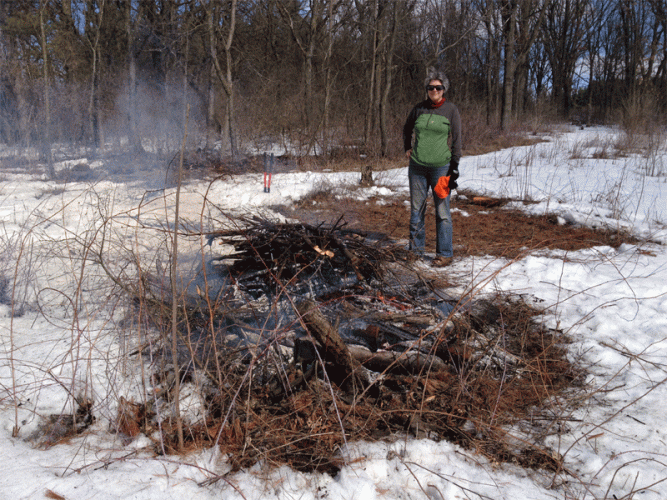Living in Underhill House is a many-faceted experience. Moving about among its unmilled, branching timbers never seems to lose its charm, and gradually working my way through all the finishing projects is very satisfying.
But what we are loving best is that now we are living on our land and can get outside in a snap to care for the 44 acres around us.

The glade has been one of our favorite work sites for many years. Now we can walk there in a few minutes.
For many years we have been pouring our vacation time and most of our “non-working” waking hours to getting ourselves out here as much as possible to help heal our little patch of land. I don’t even want to think about the hundreds and hundreds of hours spent packing the car, driving here and then back to town and unloading everything again. In the summer we hauled water and food along with changes of clothes and the tools du jour. In the winter time, all of that plus enough clothes to keep warm and snow shoes.
And I don’t want to count how many times we have found ourselves on the land or back in town only to realize that the tool we needed for the task at hand was on the other end of the commute.
Now we just step out to the porch to check the weather, pull on the appropriate overclothes in the front hall, stride off the porch, strap on snow shoes and head out for an hour or two. It is so wonderfully spontaneous and free flowing. It seems like heaven.
This past weekend, we prepared the glade for a prairie burn.
The glade is the heart of our 44. When we bought our land, a truck trail wound from the bottom of the valley all the way to the top. We named it Lloyd’s Lane after the previous owner, who blazed that trail. About half way up, there was a level section with pines to the north and an overgrown woods to the south.
Our second spring, we noticed some vivid, orange flowers in the lane that turned out to be Hoary Puccoon Lithospermum canescens.
Then we learned about the Coefficient of Conservation Concept.
Which is based on the observation that individual plant species tolerate disturbance differently. Coefficients range from 0 (highly tolerant of disturbance, little fidelity to any natural community) to 10 (highly intolerant of disturbance, restricted to pre-settlement remnants).
Those bright orange flowers that had caught our eye have a C value of 10!
We invited some area naturalists out to evaluate the site and were told that we were looking at a very rich remnant in and around the truck trail at that point. Lloyd’s Lane ran right over a jewel box of vanishing native plants that was rapidly degrading as the pines that had been planted on the north side of it were maturing, and the oaks, black walnuts and other encroached from the south.
We began work on a bypass immediately.
We’ve been working to open up the glade to sun ever since and protect this treasure trove — which is now just a few minutes’ climb up the lane from our back door.
Some of the encroaching hardwoods are now timbers that hold up our rafters. Most of their branches have been dragged into the woods to form brush pile habitat and melt back into the forest floor.
Some of those out-of-place pines have ended up as rafters in our house, and their tops and branches were piled on the edge of the glade last winter when the trees were felled.
You can’t safely have big brush piles in or near a prairie burn, so we spent last weekend stacking up and then burning the lot.
We have had bonfires in the glade before, and they are a real win-win-win situation!
- We have opened up the sky again for the sun-loving plants who have been calling this spot home since pre-settlement times.
- The intense heat of the bonfire sterilizes the ground beneath it. We always place these burns on spots where the invasive plants have become fierce. The fire creates a tabula rasa, and into that pristine place, we plant native seedlings that we purchase from the UW Arboretum spring plant sale.
- The plant sale is an arboretum fund-raiser.
It was a wonderful weekend. We prepared the site Saturday and set it alight on Sunday. We started the fire with some of our packing paper. This is the same paper that we used when we moved to Madison over 10 years ago, and used again to move to Mineral Point last September, then saved and used once more to move to Underhill House.
The newsprint packing paper has gotten a little the worse for wear each time we smooth it out, and, as we have no more plans to move, it seemed very proper to crunch some of it into little spheres and tuck it under the pine branches.
Then we spent the day feeding a very well-behaved little blaze till the site was ready to be a non-problematic part of a little prairie burn as soon as the time is right.
Then we will populate it with a few native plants. I’m thinking Prairie Smoke Geum triflorum, Cardinal Flower Lobelia cardinalis and Little Bluestem, Schizachyrium scoparium .
Categories: Eco activism, Ecosystem Restoration, Uncategorized





Hi- I stumbled across your blog here while looking online for how to build a mortared limestone wall. We live in Kansas, in an urban neighborhood. What I’m seeing on your blog is really incredible to me. I have always dreamed of doing exactly this! Using reclaimed, native, and environmentally sustainable materials to build a home is the best way. I hope you post some finished photos of your home for those of us who can’t quite make the open house. 😉 I will keep your blog bookmarked. Peace.
Thanks, Sarah.
I hope you do get to build in a sustainable way. It’s a satisfying process, and the results feel very good to live in.
If you want more info about how we built our slip form stone walls, let me know. It’s really possible to make these walls with just a couple of dedicated people and a lot of sweat. They look very rustic and are very strong.
I remember when our builder first mentioned the idea. I couldn’t really understand the concept or why we would want to, but as I learned more, I was enthusiastic and love the result.